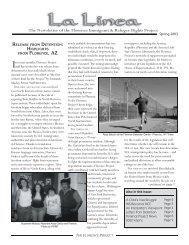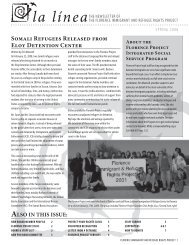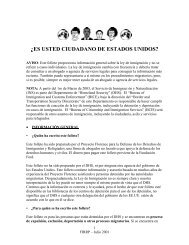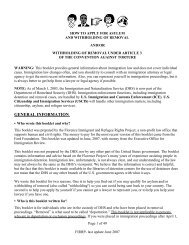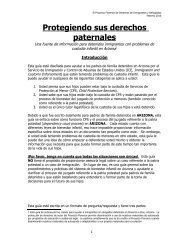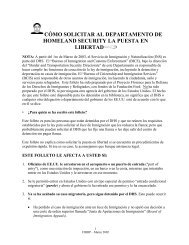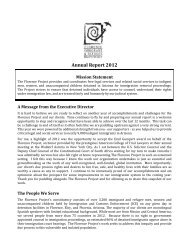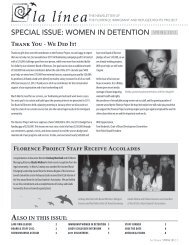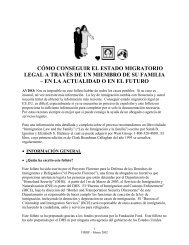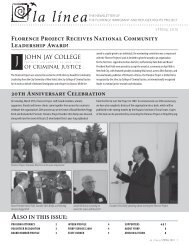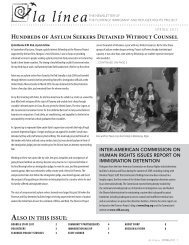quick reference chart and annotations for determining immigration ...
quick reference chart and annotations for determining immigration ...
quick reference chart and annotations for determining immigration ...
Create successful ePaper yourself
Turn your PDF publications into a flip-book with our unique Google optimized e-Paper software.
Immigrant Legal Resource Center, Florence Immigrant <strong>and</strong> Refugee Rights Project,<br />
Maricopa County Public Defender August 2012<br />
touching, fondling or manipulating of any part of the genitals, anus or female breast by any part of the<br />
body or by any object or causing a person to engage in such contact.”<br />
B. Sexual abuse is a class 5 felony unless the victim is under fifteen years of age in which case sexual<br />
abuse is a class 3 felony punishable pursuant to section 13-604.1<br />
Crime Involving Moral Turpitude (CMT): Sexual touching without the consent of a victim of<br />
any age will be held a CMT.<br />
Regarding touching the breast of a person under the age of 15, the Board of Immigration Appeals<br />
held that conviction of any consensual sexual conduct with a minor is a CIMT if the defendant knew or<br />
should have known that the victim was under age 18. Matter of Silva-Trevino, 24 I&N Dec. 687 (A.G.<br />
2008). Where possible counsel should include in the record, <strong>for</strong> example on the plea <strong>for</strong>m, a statement<br />
that the defendant reasonably believed that the victim was age 18 (or older). Without that finding, the IJ<br />
may conduct a factual inquiry into whether the defendant knew or should have known the victim was<br />
under age 18. Assuming that the IJ finds the defendant knew or should have known the victim was under<br />
18 in this inquiry, <strong>immigration</strong> counsel will argue that the Silva-Trevino st<strong>and</strong>ard itself is unreasonable if<br />
it is interpreted to mean that even this relatively innocuous sexual conduct with a minor, which under this<br />
statute does not require lewd intent, is a CIMT. While normally the Ninth Circuit will give Chevron<br />
deference to the BIA’s determination of what conduct amounts to a CIMT, it will not do so if the decision<br />
is so unreasonable as to be impermissible. See discussion of deference <strong>and</strong> moral turpitude in Marmolejo-<br />
Campos v. Holder, 558 F.3d 903 (9th Cir. 2009) (en banc). However, this argument is likely to lose<br />
be<strong>for</strong>e an Arizona <strong>immigration</strong> judge <strong>and</strong> might or might not win at the Ninth Circuit, <strong>and</strong> the client<br />
probably will be detained during the appeals.<br />
While there is no guarantee, it is possible that in the future the law will change in ways that<br />
benefit a defendant with a vague record of conviction. First, the Ninth Circuit might join other circuits<br />
<strong>and</strong> decline to follow the Silva-Trevino rule that permits an IJ to inquire into the underlying facts to<br />
determine if there is a CIMT, in the face of a vague record of conviction. If that occurs, a vague record<br />
that does not state that the defendant knew or had reason to know the victim was under 18 will prevent the<br />
offense from coming within the CIMT deportation ground. Second, as discussed above, the Ninth Circuit<br />
might decline to defer to the Silva-Trevino substantive test, that even very innocuous sexual conduct with<br />
a person whom the perpetrator knows or should know is a minor is a CIMT. Other circuit courts of<br />
appeal have rejected one or both aspects of Silva-Trevino. See e.g. Jean-Louis v. AG of the United States,<br />
582 F.3d 462 (3d Cir. 2009). Earlier the Ninth Circuit had held that even consensual sexual intercourse<br />
with a person under the age of 16 is not necessarily moral turpitude. Quintero-Salazar v. Keisler, 506<br />
F.3d 688 (9th Cir. 2007) (Calif. Penal Code § 261.5(d), which prohibits consensual intercourse between a<br />
person under the age of 16 <strong>and</strong> a person at least 21 years of age, is not categorically a crime involving<br />
moral turpitude). Again, while a defendant should raise these arguments, he or she is likely to be<br />
detained <strong>for</strong> the time until the Ninth Circuit makes a decision.<br />
Aggravated Felony: Sexual abuse of a minor. Non-consensual sexual contact with a person<br />
over the age of 15. This will not be an aggravated felony as sexual abuse of a minor as long as the record<br />
either specifies that the victim was 18 or older (but see Aggravated Felony: Crime of Violence below) or<br />
at least does not specify that the victim was under the age of 18 (conviction will not come within the<br />
aggravated felony deportation ground, but might be an aggravated felony <strong>for</strong> purposes of bars to relief<br />
from removal; see “Burden of Proof” at beginning of these <strong>annotations</strong>). If the record specifies that the<br />
victim was younger than age 18, <strong>immigration</strong> counsel can still argue that the conviction is not an<br />
aggravated felony, but this is likely to lose be<strong>for</strong>e Arizona <strong>immigration</strong> judges.<br />
Arizona Criminal Chart with Explanatory Endnote – August 2012<br />
36



